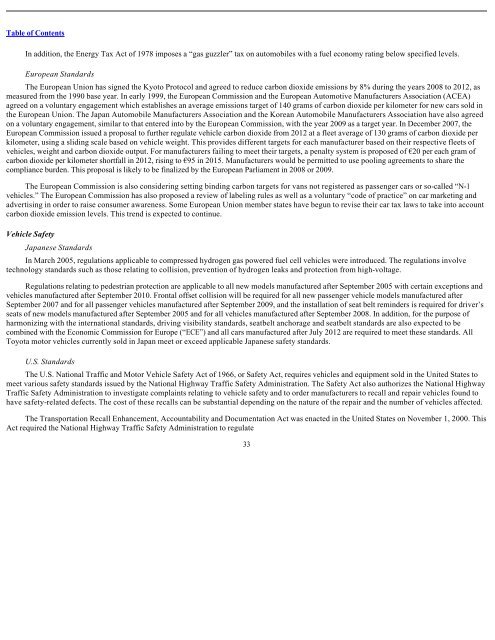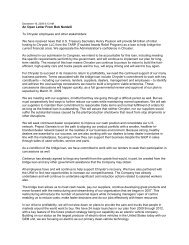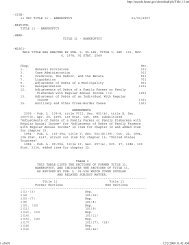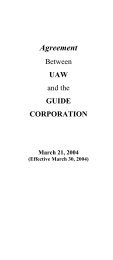toyota jidosha kabushiki kaisha toyota motor corporation - Big Three ...
toyota jidosha kabushiki kaisha toyota motor corporation - Big Three ...
toyota jidosha kabushiki kaisha toyota motor corporation - Big Three ...
You also want an ePaper? Increase the reach of your titles
YUMPU automatically turns print PDFs into web optimized ePapers that Google loves.
Table of Contents<br />
In addition, the Energy Tax Act of 1978 imposes a “gas guzzler” tax on automobiles with a fuel economy rating below specified levels.<br />
European Standards<br />
The European Union has signed the Kyoto Protocol and agreed to reduce carbon dioxide emissions by 8% during the years 2008 to 2012, as<br />
measured from the 1990 base year. In early 1999, the European Commission and the European Automotive Manufacturers Association (ACEA)<br />
agreed on a voluntary engagement which establishes an average emissions target of 140 grams of carbon dioxide per kilometer for new cars sold in<br />
the European Union. The Japan Automobile Manufacturers Association and the Korean Automobile Manufacturers Association have also agreed<br />
on a voluntary engagement, similar to that entered into by the European Commission, with the year 2009 as a target year. In December 2007, the<br />
European Commission issued a proposal to further regulate vehicle carbon dioxide from 2012 at a fleet average of 130 grams of carbon dioxide per<br />
kilometer, using a sliding scale based on vehicle weight. This provides different targets for each manufacturer based on their respective fleets of<br />
vehicles, weight and carbon dioxide output. For manufacturers failing to meet their targets, a penalty system is proposed of €20 per each gram of<br />
carbon dioxide per kilometer shortfall in 2012, rising to €95 in 2015. Manufacturers would be permitted to use pooling agreements to share the<br />
compliance burden. This proposal is likely to be finalized by the European Parliament in 2008 or 2009.<br />
The European Commission is also considering setting binding carbon targets for vans not registered as passenger cars or so-called “N-1<br />
vehicles.” The European Commission has also proposed a review of labeling rules as well as a voluntary “code of practice” on car marketing and<br />
advertising in order to raise consumer awareness. Some European Union member states have begun to revise their car tax laws to take into account<br />
carbon dioxide emission levels. This trend is expected to continue.<br />
Vehicle Safety<br />
Japanese Standards<br />
In March 2005, regulations applicable to compressed hydrogen gas powered fuel cell vehicles were introduced. The regulations involve<br />
technology standards such as those relating to collision, prevention of hydrogen leaks and protection from high-voltage.<br />
Regulations relating to pedestrian protection are applicable to all new models manufactured after September 2005 with certain exceptions and<br />
vehicles manufactured after September 2010. Frontal offset collision will be required for all new passenger vehicle models manufactured after<br />
September 2007 and for all passenger vehicles manufactured after September 2009, and the installation of seat belt reminders is required for driver’s<br />
seats of new models manufactured after September 2005 and for all vehicles manufactured after September 2008. In addition, for the purpose of<br />
harmonizing with the international standards, driving visibility standards, seatbelt anchorage and seatbelt standards are also expected to be<br />
combined with the Economic Commission for Europe (“ECE”) and all cars manufactured after July 2012 are required to meet these standards. All<br />
Toyota <strong>motor</strong> vehicles currently sold in Japan meet or exceed applicable Japanese safety standards.<br />
U.S. Standards<br />
The U.S. National Traffic and Motor Vehicle Safety Act of 1966, or Safety Act, requires vehicles and equipment sold in the United States to<br />
meet various safety standards issued by the National Highway Traffic Safety Administration. The Safety Act also authorizes the National Highway<br />
Traffic Safety Administration to investigate complaints relating to vehicle safety and to order manufacturers to recall and repair vehicles found to<br />
have safety-related defects. The cost of these recalls can be substantial depending on the nature of the repair and the number of vehicles affected.<br />
The Transportation Recall Enhancement, Accountability and Documentation Act was enacted in the United States on November 1, 2000. This<br />
Act required the National Highway Traffic Safety Administration to regulate<br />
33







